Investigating Sexual Harassment: A Case Study of Dubois Industry
VerifiedAdded on 2023/06/11
|13
|3043
|120
Case Study
AI Summary
This case study explores the issue of sexual harassment at Dubois Industry, focusing on the experiences of women employees. It investigates the nature and extent of harassment, its effects on employees and the organization, and potential preventative measures. The research employs both qualitative and quantitative methods, including questionnaires and interviews with employees and HR managers, to gather data on the types of harassment, perpetrators, and company policies. Ethical implications are considered, and a timetable and budget for the research are provided. The study aims to understand how women manage harassment, assess the effectiveness of existing policies, and propose recommendations for creating a safer and more equitable workplace at Dubois Industry. The research also highlights the need for proactive and gender-sensitive practices within the organization.
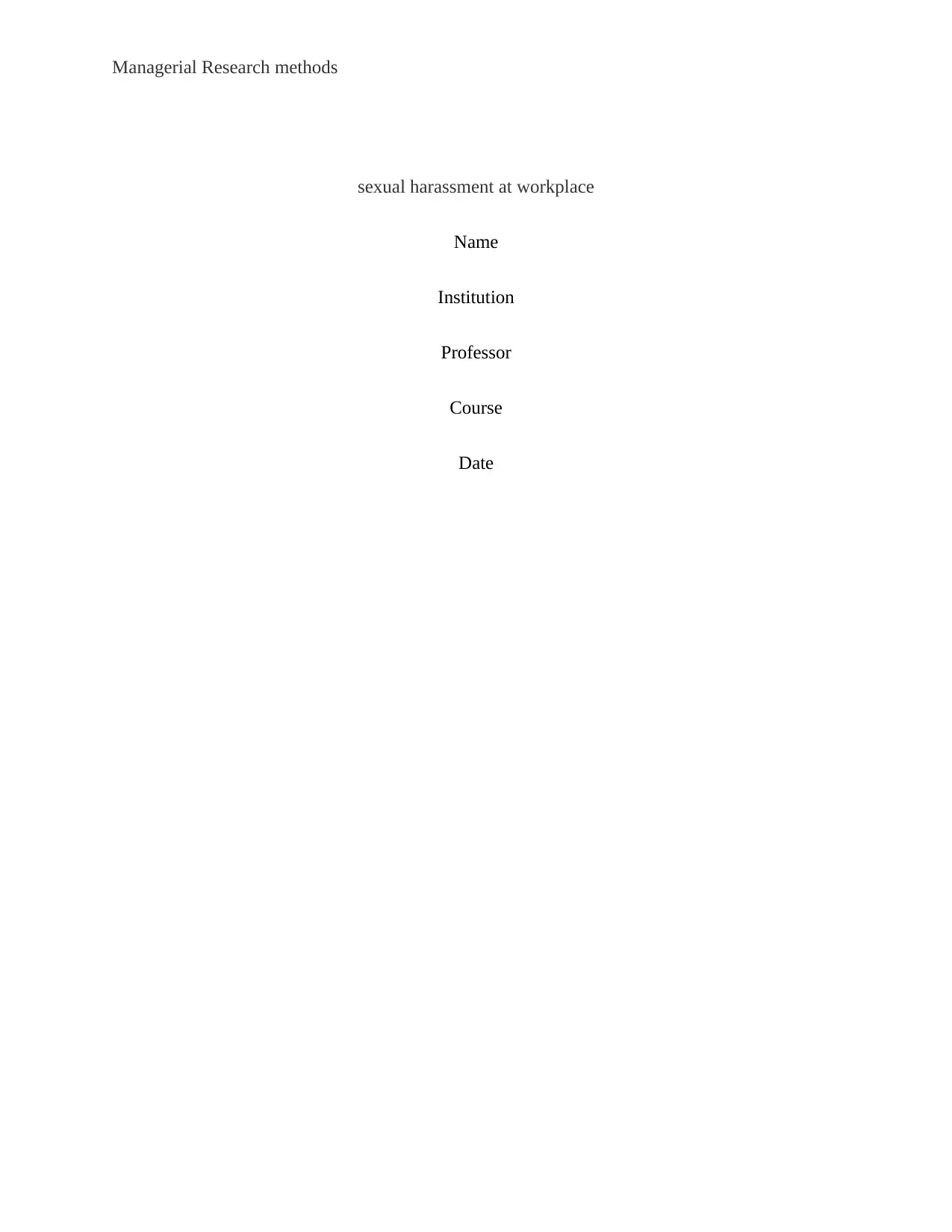
Managerial Research methods
sexual harassment at workplace
Name
Institution
Professor
Course
Date
sexual harassment at workplace
Name
Institution
Professor
Course
Date
Paraphrase This Document
Need a fresh take? Get an instant paraphrase of this document with our AI Paraphraser
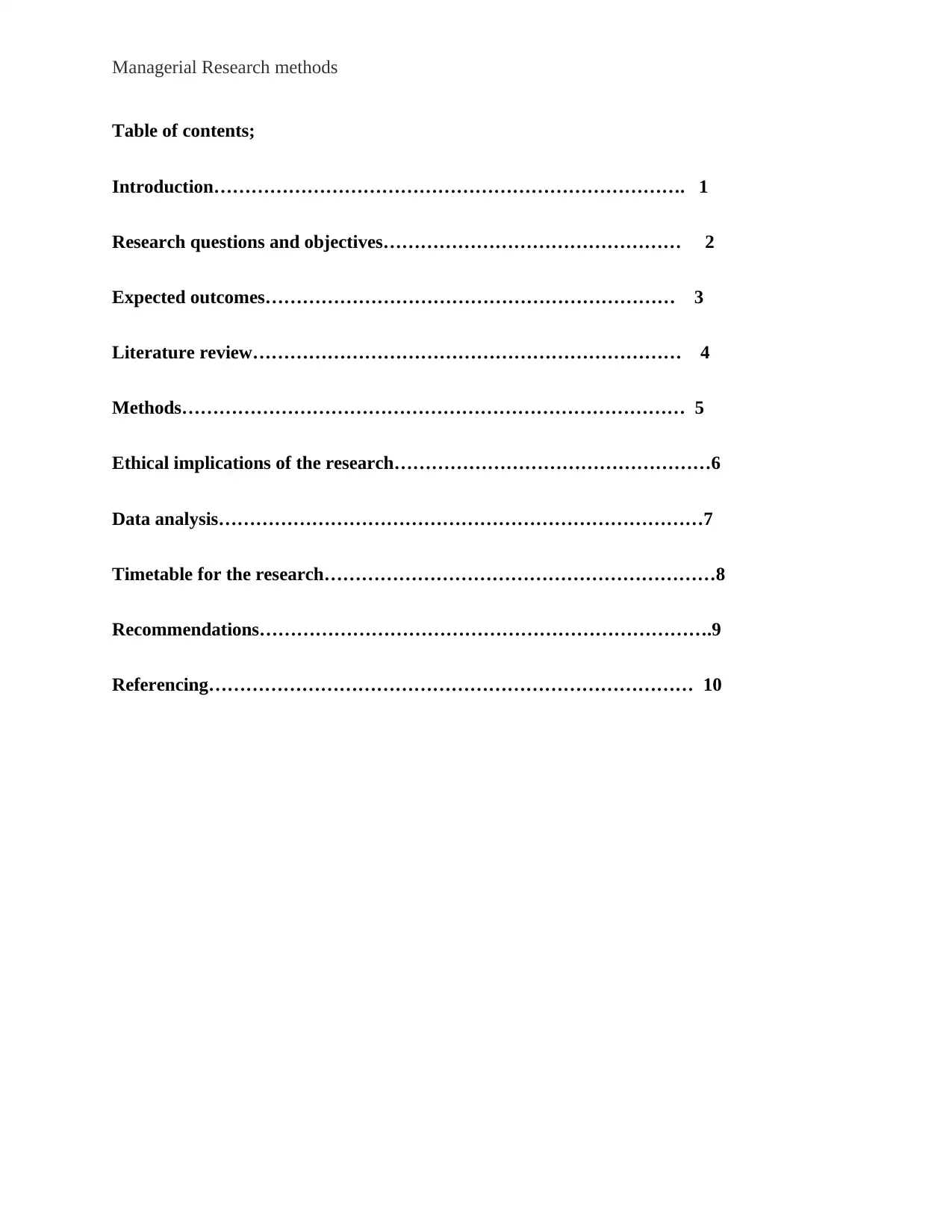
Managerial Research methods
Table of contents;
Introduction…………………………………………………………………. 1
Research questions and objectives………………………………………… 2
Expected outcomes………………………………………………………… 3
Literature review…………………………………………………………… 4
Methods……………………………………………………………………… 5
Ethical implications of the research……………………………………………6
Data analysis……………………………………………………………………7
Timetable for the research………………………………………………………8
Recommendations……………………………………………………………….9
Referencing…………………………………………………………………… 10
Table of contents;
Introduction…………………………………………………………………. 1
Research questions and objectives………………………………………… 2
Expected outcomes………………………………………………………… 3
Literature review…………………………………………………………… 4
Methods……………………………………………………………………… 5
Ethical implications of the research……………………………………………6
Data analysis……………………………………………………………………7
Timetable for the research………………………………………………………8
Recommendations……………………………………………………………….9
Referencing…………………………………………………………………… 10
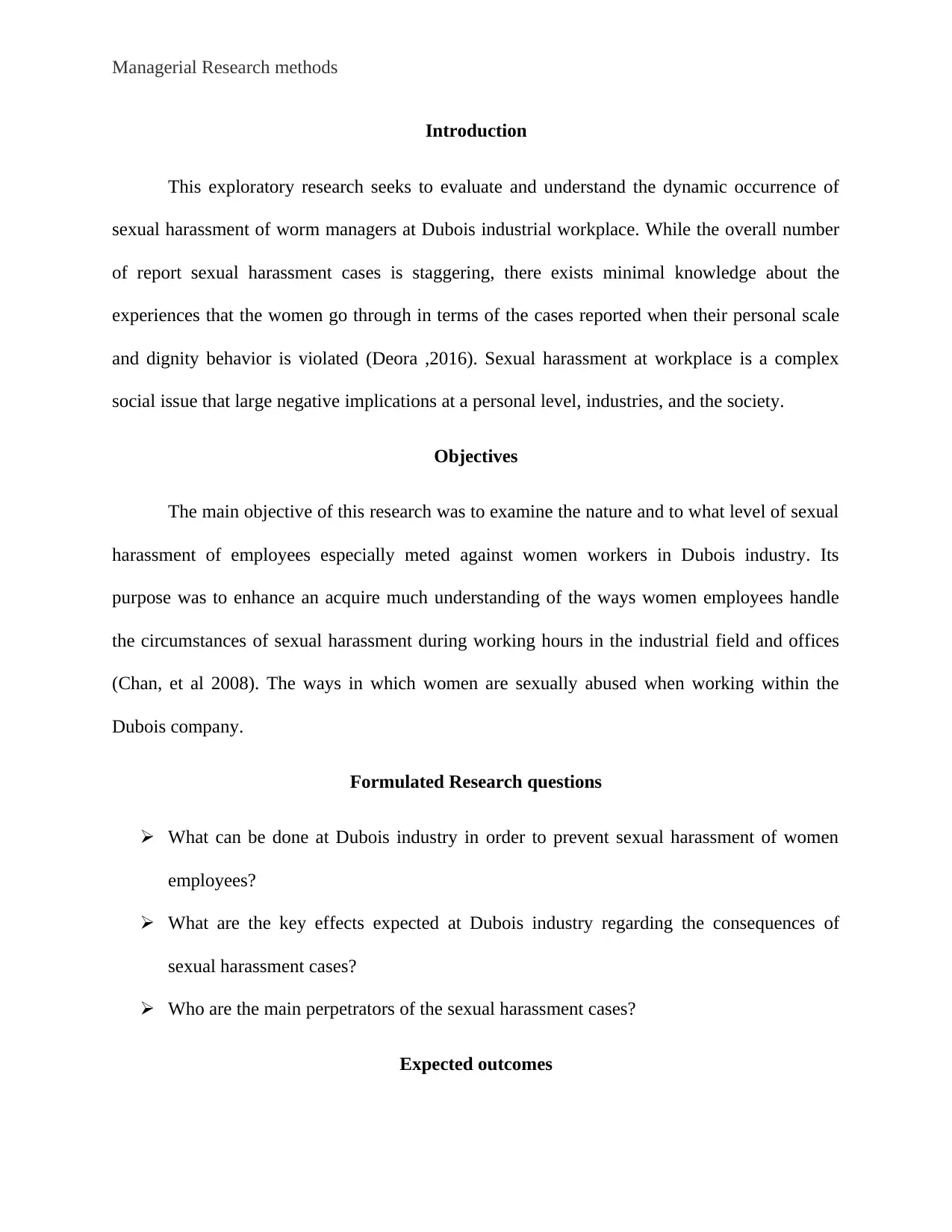
Managerial Research methods
Introduction
This exploratory research seeks to evaluate and understand the dynamic occurrence of
sexual harassment of worm managers at Dubois industrial workplace. While the overall number
of report sexual harassment cases is staggering, there exists minimal knowledge about the
experiences that the women go through in terms of the cases reported when their personal scale
and dignity behavior is violated (Deora ,2016). Sexual harassment at workplace is a complex
social issue that large negative implications at a personal level, industries, and the society.
Objectives
The main objective of this research was to examine the nature and to what level of sexual
harassment of employees especially meted against women workers in Dubois industry. Its
purpose was to enhance an acquire much understanding of the ways women employees handle
the circumstances of sexual harassment during working hours in the industrial field and offices
(Chan, et al 2008). The ways in which women are sexually abused when working within the
Dubois company.
Formulated Research questions
What can be done at Dubois industry in order to prevent sexual harassment of women
employees?
What are the key effects expected at Dubois industry regarding the consequences of
sexual harassment cases?
Who are the main perpetrators of the sexual harassment cases?
Expected outcomes
Introduction
This exploratory research seeks to evaluate and understand the dynamic occurrence of
sexual harassment of worm managers at Dubois industrial workplace. While the overall number
of report sexual harassment cases is staggering, there exists minimal knowledge about the
experiences that the women go through in terms of the cases reported when their personal scale
and dignity behavior is violated (Deora ,2016). Sexual harassment at workplace is a complex
social issue that large negative implications at a personal level, industries, and the society.
Objectives
The main objective of this research was to examine the nature and to what level of sexual
harassment of employees especially meted against women workers in Dubois industry. Its
purpose was to enhance an acquire much understanding of the ways women employees handle
the circumstances of sexual harassment during working hours in the industrial field and offices
(Chan, et al 2008). The ways in which women are sexually abused when working within the
Dubois company.
Formulated Research questions
What can be done at Dubois industry in order to prevent sexual harassment of women
employees?
What are the key effects expected at Dubois industry regarding the consequences of
sexual harassment cases?
Who are the main perpetrators of the sexual harassment cases?
Expected outcomes
⊘ This is a preview!⊘
Do you want full access?
Subscribe today to unlock all pages.

Trusted by 1+ million students worldwide
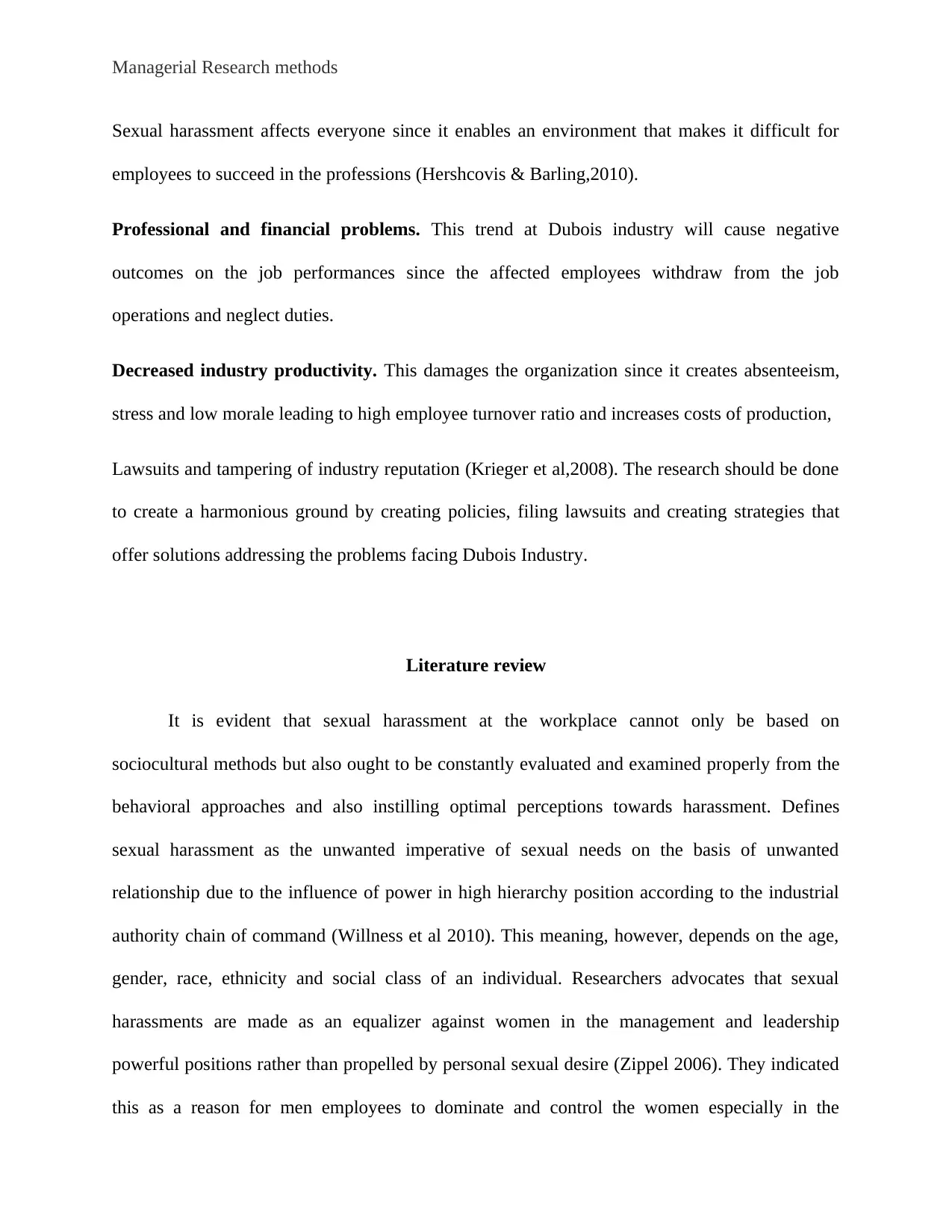
Managerial Research methods
Sexual harassment affects everyone since it enables an environment that makes it difficult for
employees to succeed in the professions (Hershcovis & Barling,2010).
Professional and financial problems. This trend at Dubois industry will cause negative
outcomes on the job performances since the affected employees withdraw from the job
operations and neglect duties.
Decreased industry productivity. This damages the organization since it creates absenteeism,
stress and low morale leading to high employee turnover ratio and increases costs of production,
Lawsuits and tampering of industry reputation (Krieger et al,2008). The research should be done
to create a harmonious ground by creating policies, filing lawsuits and creating strategies that
offer solutions addressing the problems facing Dubois Industry.
Literature review
It is evident that sexual harassment at the workplace cannot only be based on
sociocultural methods but also ought to be constantly evaluated and examined properly from the
behavioral approaches and also instilling optimal perceptions towards harassment. Defines
sexual harassment as the unwanted imperative of sexual needs on the basis of unwanted
relationship due to the influence of power in high hierarchy position according to the industrial
authority chain of command (Willness et al 2010). This meaning, however, depends on the age,
gender, race, ethnicity and social class of an individual. Researchers advocates that sexual
harassments are made as an equalizer against women in the management and leadership
powerful positions rather than propelled by personal sexual desire (Zippel 2006). They indicated
this as a reason for men employees to dominate and control the women especially in the
Sexual harassment affects everyone since it enables an environment that makes it difficult for
employees to succeed in the professions (Hershcovis & Barling,2010).
Professional and financial problems. This trend at Dubois industry will cause negative
outcomes on the job performances since the affected employees withdraw from the job
operations and neglect duties.
Decreased industry productivity. This damages the organization since it creates absenteeism,
stress and low morale leading to high employee turnover ratio and increases costs of production,
Lawsuits and tampering of industry reputation (Krieger et al,2008). The research should be done
to create a harmonious ground by creating policies, filing lawsuits and creating strategies that
offer solutions addressing the problems facing Dubois Industry.
Literature review
It is evident that sexual harassment at the workplace cannot only be based on
sociocultural methods but also ought to be constantly evaluated and examined properly from the
behavioral approaches and also instilling optimal perceptions towards harassment. Defines
sexual harassment as the unwanted imperative of sexual needs on the basis of unwanted
relationship due to the influence of power in high hierarchy position according to the industrial
authority chain of command (Willness et al 2010). This meaning, however, depends on the age,
gender, race, ethnicity and social class of an individual. Researchers advocates that sexual
harassments are made as an equalizer against women in the management and leadership
powerful positions rather than propelled by personal sexual desire (Zippel 2006). They indicated
this as a reason for men employees to dominate and control the women especially in the
Paraphrase This Document
Need a fresh take? Get an instant paraphrase of this document with our AI Paraphraser
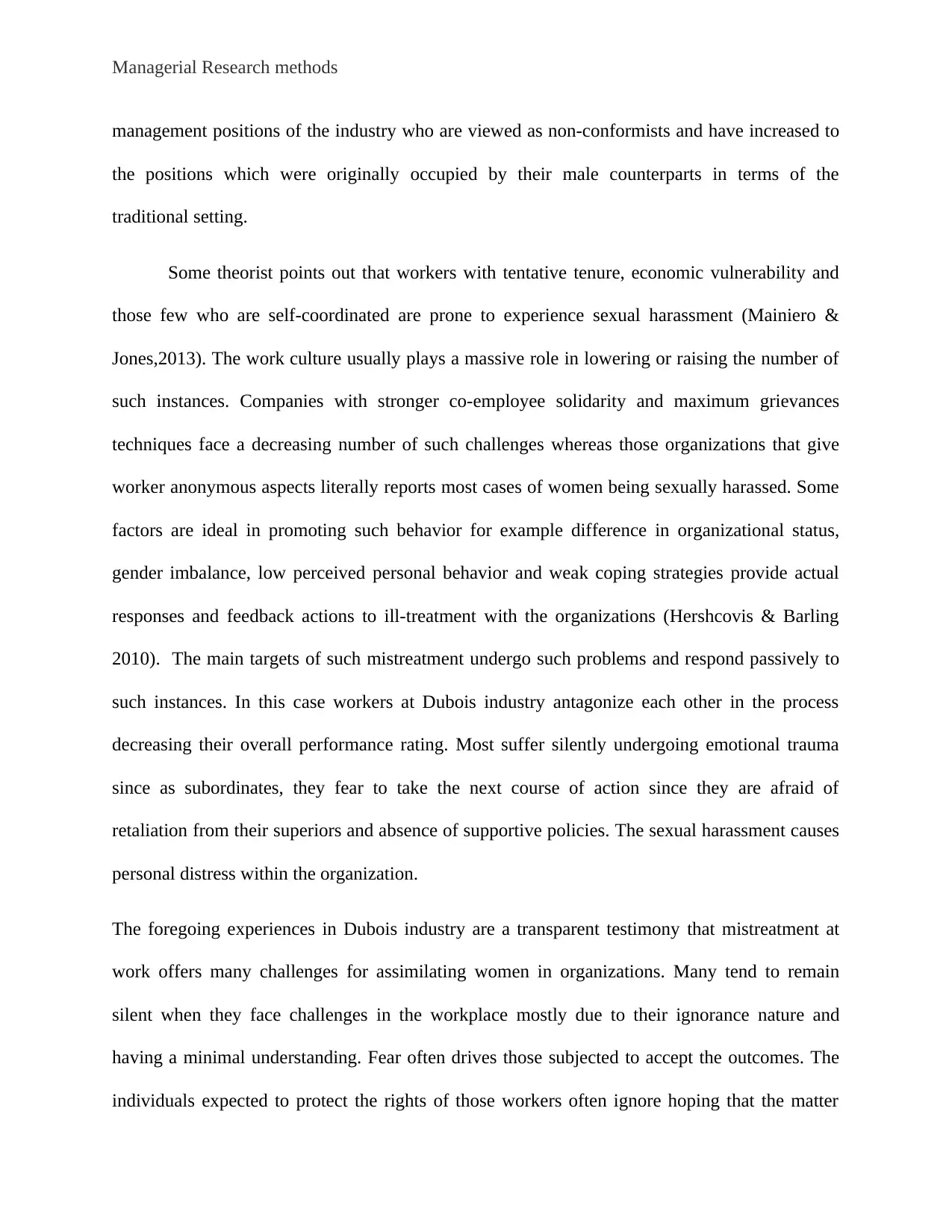
Managerial Research methods
management positions of the industry who are viewed as non-conformists and have increased to
the positions which were originally occupied by their male counterparts in terms of the
traditional setting.
Some theorist points out that workers with tentative tenure, economic vulnerability and
those few who are self-coordinated are prone to experience sexual harassment (Mainiero &
Jones,2013). The work culture usually plays a massive role in lowering or raising the number of
such instances. Companies with stronger co-employee solidarity and maximum grievances
techniques face a decreasing number of such challenges whereas those organizations that give
worker anonymous aspects literally reports most cases of women being sexually harassed. Some
factors are ideal in promoting such behavior for example difference in organizational status,
gender imbalance, low perceived personal behavior and weak coping strategies provide actual
responses and feedback actions to ill-treatment with the organizations (Hershcovis & Barling
2010). The main targets of such mistreatment undergo such problems and respond passively to
such instances. In this case workers at Dubois industry antagonize each other in the process
decreasing their overall performance rating. Most suffer silently undergoing emotional trauma
since as subordinates, they fear to take the next course of action since they are afraid of
retaliation from their superiors and absence of supportive policies. The sexual harassment causes
personal distress within the organization.
The foregoing experiences in Dubois industry are a transparent testimony that mistreatment at
work offers many challenges for assimilating women in organizations. Many tend to remain
silent when they face challenges in the workplace mostly due to their ignorance nature and
having a minimal understanding. Fear often drives those subjected to accept the outcomes. The
individuals expected to protect the rights of those workers often ignore hoping that the matter
management positions of the industry who are viewed as non-conformists and have increased to
the positions which were originally occupied by their male counterparts in terms of the
traditional setting.
Some theorist points out that workers with tentative tenure, economic vulnerability and
those few who are self-coordinated are prone to experience sexual harassment (Mainiero &
Jones,2013). The work culture usually plays a massive role in lowering or raising the number of
such instances. Companies with stronger co-employee solidarity and maximum grievances
techniques face a decreasing number of such challenges whereas those organizations that give
worker anonymous aspects literally reports most cases of women being sexually harassed. Some
factors are ideal in promoting such behavior for example difference in organizational status,
gender imbalance, low perceived personal behavior and weak coping strategies provide actual
responses and feedback actions to ill-treatment with the organizations (Hershcovis & Barling
2010). The main targets of such mistreatment undergo such problems and respond passively to
such instances. In this case workers at Dubois industry antagonize each other in the process
decreasing their overall performance rating. Most suffer silently undergoing emotional trauma
since as subordinates, they fear to take the next course of action since they are afraid of
retaliation from their superiors and absence of supportive policies. The sexual harassment causes
personal distress within the organization.
The foregoing experiences in Dubois industry are a transparent testimony that mistreatment at
work offers many challenges for assimilating women in organizations. Many tend to remain
silent when they face challenges in the workplace mostly due to their ignorance nature and
having a minimal understanding. Fear often drives those subjected to accept the outcomes. The
individuals expected to protect the rights of those workers often ignore hoping that the matter

Managerial Research methods
will be solved at last and sorted on its own (Hershcovis & Barling 2010). The research focuses
on the women. The focus on women was due to limited qualitative research on the overall
employees. Context. It also propelled getting a higher understanding of the industry policies and
practices defined with an aim of safeguarding the personal interests and reputations of women
workers as mandated by rules, regulations and government law (Mainiero & Jones 2013). The
purpose was to learn from the past experiences of such instances and outline important measures
for strengthening the industry process in order to finally secure the workplace. This will, in turn,
promote a good public image of goodwill regarding Dubois industry. It attempts to explore how
the women workers manage such bad behavior done on them and also what type of available
measures, policies, and processes that Dubois industry take action in protecting them from being
sexually harmed by their other male counterparts. Also, the actions taken seeks to establish
whether the enactment of the law of the land is adequate enough in safeguarding the personal
interests and the public image of goodwill of the company (Deora 2016). This research
facilitates the drawing of attention to the practices instituted by the industry in matters regarding
proactivity and gender-sensitive areas. It aims to unleash the hidden cover up regarding sexual
harassment of junior employees by the top level managers.
In the last years, several laws and institutional measures have been enacted suggesting
that women continue to be discriminated and mistreated within formally organization and
unorganized informal industrial setting. It's clear that an alarming 88% of the 200 employees
between the age bracket of 22-44 years of age have reported to being sexually harassed to not
only in Dubois industry but also other companies across different cities in the world. Interview
with a large sample of women at Dubois industry should be done to reveal an exact percentage of
women facing sexual harassment at the workplace (Willness et al, 2007). The findings indicate
will be solved at last and sorted on its own (Hershcovis & Barling 2010). The research focuses
on the women. The focus on women was due to limited qualitative research on the overall
employees. Context. It also propelled getting a higher understanding of the industry policies and
practices defined with an aim of safeguarding the personal interests and reputations of women
workers as mandated by rules, regulations and government law (Mainiero & Jones 2013). The
purpose was to learn from the past experiences of such instances and outline important measures
for strengthening the industry process in order to finally secure the workplace. This will, in turn,
promote a good public image of goodwill regarding Dubois industry. It attempts to explore how
the women workers manage such bad behavior done on them and also what type of available
measures, policies, and processes that Dubois industry take action in protecting them from being
sexually harmed by their other male counterparts. Also, the actions taken seeks to establish
whether the enactment of the law of the land is adequate enough in safeguarding the personal
interests and the public image of goodwill of the company (Deora 2016). This research
facilitates the drawing of attention to the practices instituted by the industry in matters regarding
proactivity and gender-sensitive areas. It aims to unleash the hidden cover up regarding sexual
harassment of junior employees by the top level managers.
In the last years, several laws and institutional measures have been enacted suggesting
that women continue to be discriminated and mistreated within formally organization and
unorganized informal industrial setting. It's clear that an alarming 88% of the 200 employees
between the age bracket of 22-44 years of age have reported to being sexually harassed to not
only in Dubois industry but also other companies across different cities in the world. Interview
with a large sample of women at Dubois industry should be done to reveal an exact percentage of
women facing sexual harassment at the workplace (Willness et al, 2007). The findings indicate
⊘ This is a preview!⊘
Do you want full access?
Subscribe today to unlock all pages.

Trusted by 1+ million students worldwide
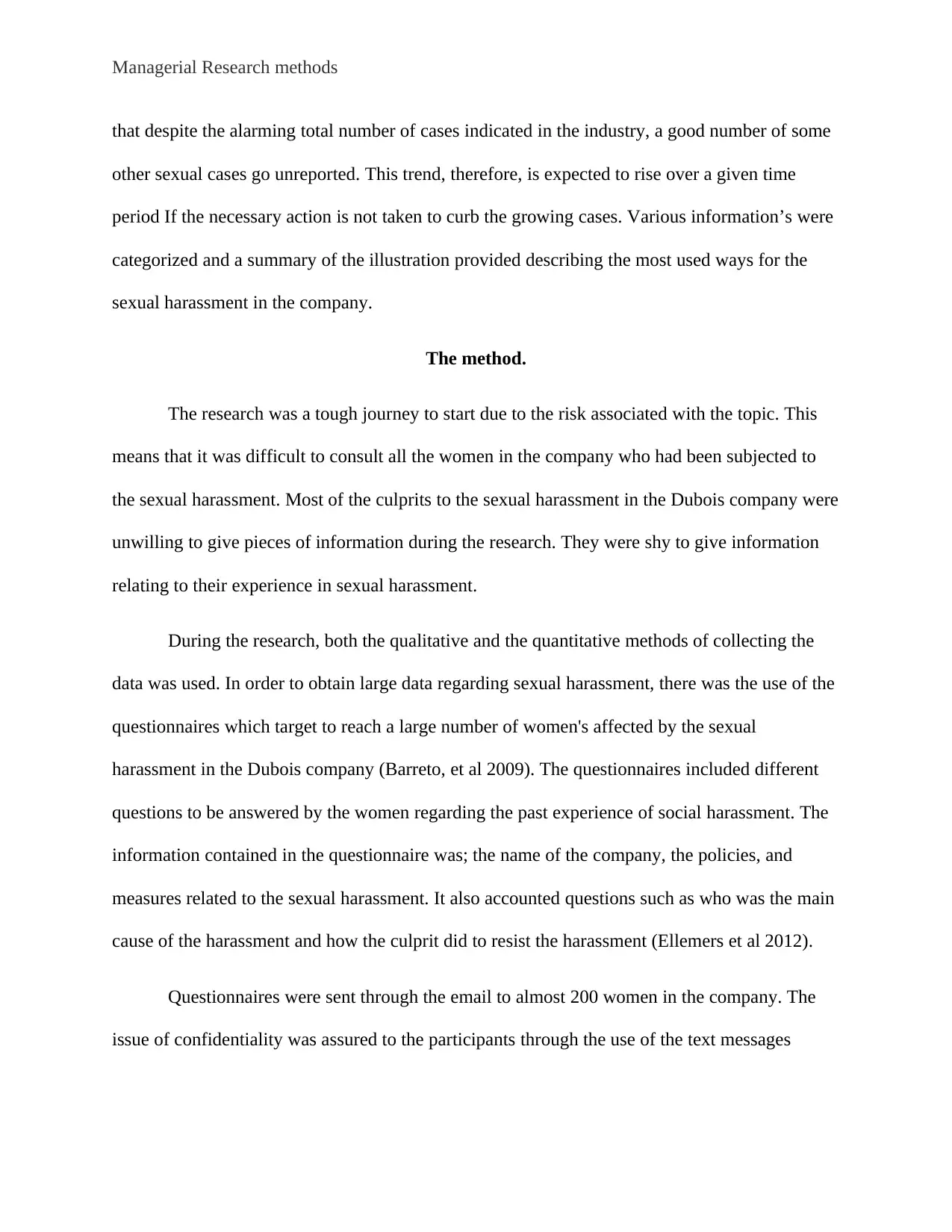
Managerial Research methods
that despite the alarming total number of cases indicated in the industry, a good number of some
other sexual cases go unreported. This trend, therefore, is expected to rise over a given time
period If the necessary action is not taken to curb the growing cases. Various information’s were
categorized and a summary of the illustration provided describing the most used ways for the
sexual harassment in the company.
The method.
The research was a tough journey to start due to the risk associated with the topic. This
means that it was difficult to consult all the women in the company who had been subjected to
the sexual harassment. Most of the culprits to the sexual harassment in the Dubois company were
unwilling to give pieces of information during the research. They were shy to give information
relating to their experience in sexual harassment.
During the research, both the qualitative and the quantitative methods of collecting the
data was used. In order to obtain large data regarding sexual harassment, there was the use of the
questionnaires which target to reach a large number of women's affected by the sexual
harassment in the Dubois company (Barreto, et al 2009). The questionnaires included different
questions to be answered by the women regarding the past experience of social harassment. The
information contained in the questionnaire was; the name of the company, the policies, and
measures related to the sexual harassment. It also accounted questions such as who was the main
cause of the harassment and how the culprit did to resist the harassment (Ellemers et al 2012).
Questionnaires were sent through the email to almost 200 women in the company. The
issue of confidentiality was assured to the participants through the use of the text messages
that despite the alarming total number of cases indicated in the industry, a good number of some
other sexual cases go unreported. This trend, therefore, is expected to rise over a given time
period If the necessary action is not taken to curb the growing cases. Various information’s were
categorized and a summary of the illustration provided describing the most used ways for the
sexual harassment in the company.
The method.
The research was a tough journey to start due to the risk associated with the topic. This
means that it was difficult to consult all the women in the company who had been subjected to
the sexual harassment. Most of the culprits to the sexual harassment in the Dubois company were
unwilling to give pieces of information during the research. They were shy to give information
relating to their experience in sexual harassment.
During the research, both the qualitative and the quantitative methods of collecting the
data was used. In order to obtain large data regarding sexual harassment, there was the use of the
questionnaires which target to reach a large number of women's affected by the sexual
harassment in the Dubois company (Barreto, et al 2009). The questionnaires included different
questions to be answered by the women regarding the past experience of social harassment. The
information contained in the questionnaire was; the name of the company, the policies, and
measures related to the sexual harassment. It also accounted questions such as who was the main
cause of the harassment and how the culprit did to resist the harassment (Ellemers et al 2012).
Questionnaires were sent through the email to almost 200 women in the company. The
issue of confidentiality was assured to the participants through the use of the text messages
Paraphrase This Document
Need a fresh take? Get an instant paraphrase of this document with our AI Paraphraser

Managerial Research methods
through their phones informing them that much confidentiality was taken into account. Sampling
was used to select the participants in the company.
Data collection.
The questionnaire provided information's which portrayed the image of the sexual abuse,
and the tough measures which women were undergoing. It provided the perpetrators of the abuse
and the steps which were taken to handle the incidence in the company. Use of analytical
methods for obtaining the appropriate data was used. This was through the interview whereby
open information form the victims was recorded. The time length for each interview was
approximately 2 hours whereby the respondent was received from the women in the company
(Barreto, et al 2009). The information gotten through the interview was recorded and then
transcribed. The direct interviews were done with the HR managers in different departments
within the company. The interview comprised the complex policies of the company, the sexual
abuse, the type of the abuse that occurs in working place and how to handle the harassment in the
company (Barreto, et al 2009).
Ethical implications of the research
Carrying out research regarding the sexual harassment in any organization has a lot of
risks. The researcher faces a lot of challenges when trying to investigate cases of sexual
harassment in an organization (Barreto, et al 2009).
Threats from the perpetrators caused a big challenge to obtain the appropriate information. This
means that sexual harassment has been practiced by the company for a long time implying that
the company is not ethical thus unsuitable for the tenders.
through their phones informing them that much confidentiality was taken into account. Sampling
was used to select the participants in the company.
Data collection.
The questionnaire provided information's which portrayed the image of the sexual abuse,
and the tough measures which women were undergoing. It provided the perpetrators of the abuse
and the steps which were taken to handle the incidence in the company. Use of analytical
methods for obtaining the appropriate data was used. This was through the interview whereby
open information form the victims was recorded. The time length for each interview was
approximately 2 hours whereby the respondent was received from the women in the company
(Barreto, et al 2009). The information gotten through the interview was recorded and then
transcribed. The direct interviews were done with the HR managers in different departments
within the company. The interview comprised the complex policies of the company, the sexual
abuse, the type of the abuse that occurs in working place and how to handle the harassment in the
company (Barreto, et al 2009).
Ethical implications of the research
Carrying out research regarding the sexual harassment in any organization has a lot of
risks. The researcher faces a lot of challenges when trying to investigate cases of sexual
harassment in an organization (Barreto, et al 2009).
Threats from the perpetrators caused a big challenge to obtain the appropriate information. This
means that sexual harassment has been practiced by the company for a long time implying that
the company is not ethical thus unsuitable for the tenders.

Managerial Research methods
The fear among the victims. Most of the women interviewed revealed that there was fear when
talking the truth. This tells us that sexual harassment is at high peak within the company thus
making the company unethical (Barreto, et al 2009).
Data analysis
Results
The need to answer the objective of the research on what sexual behaviors have been
used by the workers in the company. The answer to this question was presented in two ways that
are categorizing the sex behaviors as either general type and as behavior targeted to individuals.
Generalized sexual harassment behavior in Dubois company.
Telling of sexual jokes and the stories by the workers in the company, use of sexual languages,
using sexual body gestures and distributing sexual explicit contents such as pornographic videos
and other objects related to sexual harassment in the company (Ellemers et al 2012).
The targeted sexual behaviors recorded in the questionnaires were; Making some welcoming
comments relating to sexual activities, sending messages with sex materials, attempts to catch
someone's body, making sexual assault to someone in the company, allocation of job positions in
return to sex and also use of abusive languages when one refuses to have sex affairs.
Timetable of the research
The fear among the victims. Most of the women interviewed revealed that there was fear when
talking the truth. This tells us that sexual harassment is at high peak within the company thus
making the company unethical (Barreto, et al 2009).
Data analysis
Results
The need to answer the objective of the research on what sexual behaviors have been
used by the workers in the company. The answer to this question was presented in two ways that
are categorizing the sex behaviors as either general type and as behavior targeted to individuals.
Generalized sexual harassment behavior in Dubois company.
Telling of sexual jokes and the stories by the workers in the company, use of sexual languages,
using sexual body gestures and distributing sexual explicit contents such as pornographic videos
and other objects related to sexual harassment in the company (Ellemers et al 2012).
The targeted sexual behaviors recorded in the questionnaires were; Making some welcoming
comments relating to sexual activities, sending messages with sex materials, attempts to catch
someone's body, making sexual assault to someone in the company, allocation of job positions in
return to sex and also use of abusive languages when one refuses to have sex affairs.
Timetable of the research
⊘ This is a preview!⊘
Do you want full access?
Subscribe today to unlock all pages.

Trusted by 1+ million students worldwide
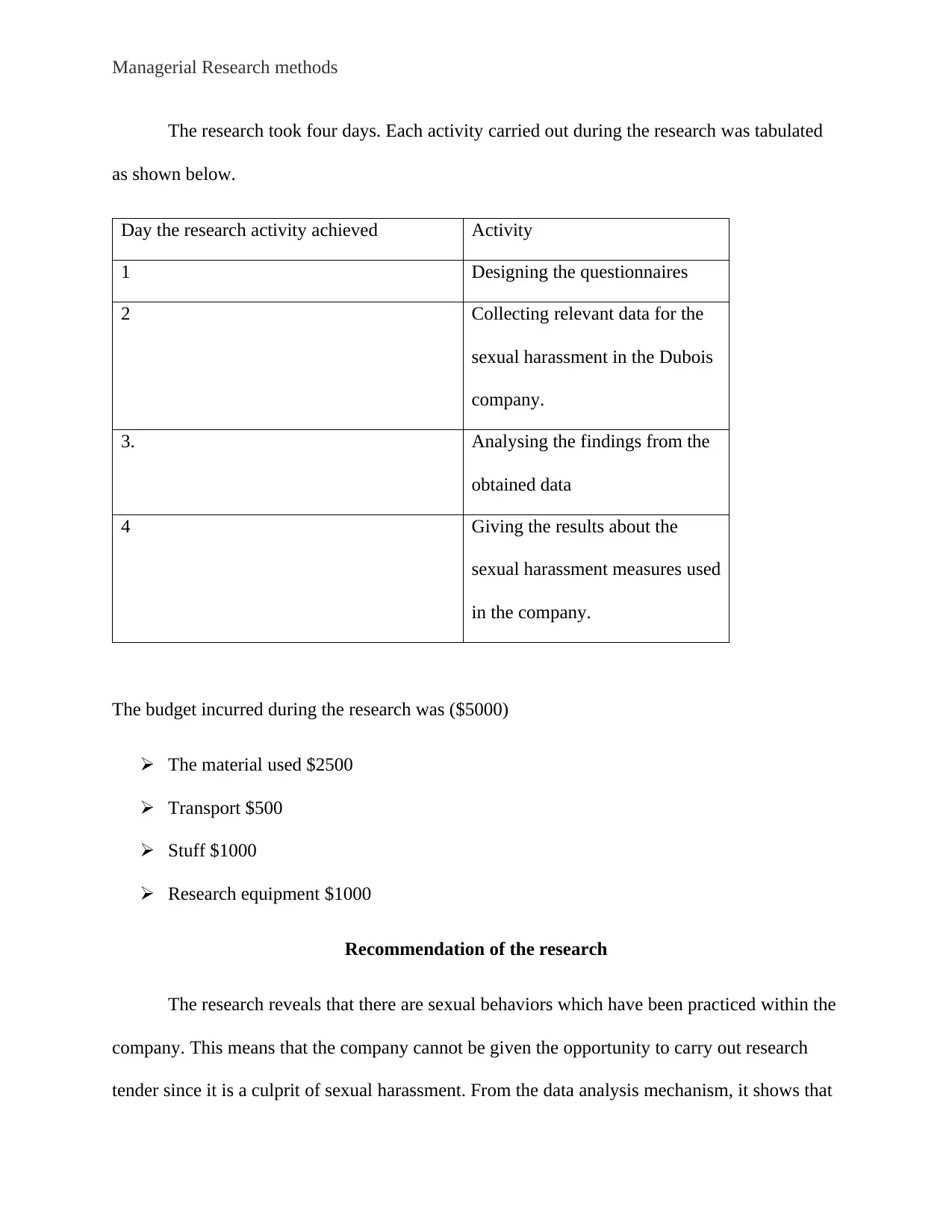
Managerial Research methods
The research took four days. Each activity carried out during the research was tabulated
as shown below.
Day the research activity achieved Activity
1 Designing the questionnaires
2 Collecting relevant data for the
sexual harassment in the Dubois
company.
3. Analysing the findings from the
obtained data
4 Giving the results about the
sexual harassment measures used
in the company.
The budget incurred during the research was ($5000)
The material used $2500
Transport $500
Stuff $1000
Research equipment $1000
Recommendation of the research
The research reveals that there are sexual behaviors which have been practiced within the
company. This means that the company cannot be given the opportunity to carry out research
tender since it is a culprit of sexual harassment. From the data analysis mechanism, it shows that
The research took four days. Each activity carried out during the research was tabulated
as shown below.
Day the research activity achieved Activity
1 Designing the questionnaires
2 Collecting relevant data for the
sexual harassment in the Dubois
company.
3. Analysing the findings from the
obtained data
4 Giving the results about the
sexual harassment measures used
in the company.
The budget incurred during the research was ($5000)
The material used $2500
Transport $500
Stuff $1000
Research equipment $1000
Recommendation of the research
The research reveals that there are sexual behaviors which have been practiced within the
company. This means that the company cannot be given the opportunity to carry out research
tender since it is a culprit of sexual harassment. From the data analysis mechanism, it shows that
Paraphrase This Document
Need a fresh take? Get an instant paraphrase of this document with our AI Paraphraser
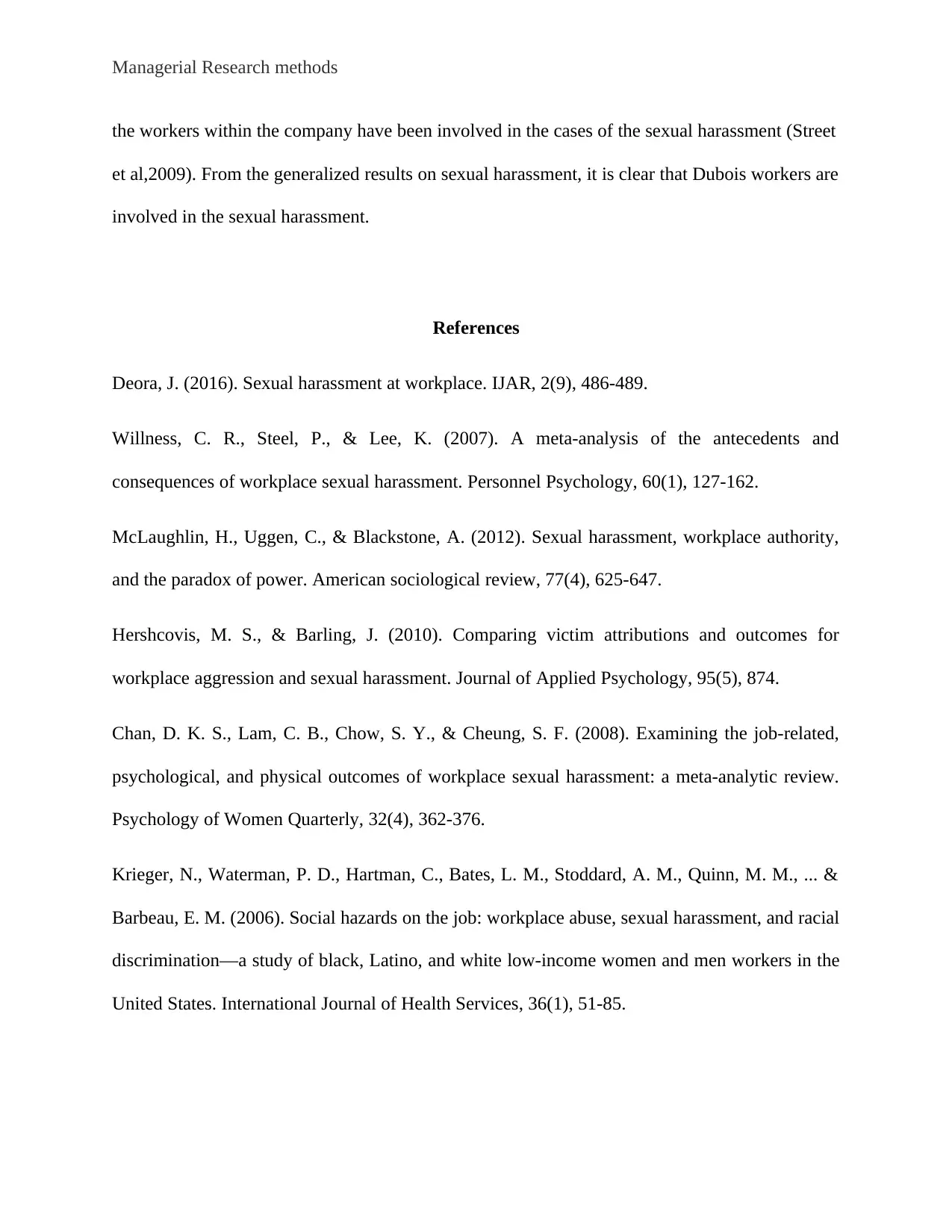
Managerial Research methods
the workers within the company have been involved in the cases of the sexual harassment (Street
et al,2009). From the generalized results on sexual harassment, it is clear that Dubois workers are
involved in the sexual harassment.
References
Deora, J. (2016). Sexual harassment at workplace. IJAR, 2(9), 486-489.
Willness, C. R., Steel, P., & Lee, K. (2007). A meta‐analysis of the antecedents and
consequences of workplace sexual harassment. Personnel Psychology, 60(1), 127-162.
McLaughlin, H., Uggen, C., & Blackstone, A. (2012). Sexual harassment, workplace authority,
and the paradox of power. American sociological review, 77(4), 625-647.
Hershcovis, M. S., & Barling, J. (2010). Comparing victim attributions and outcomes for
workplace aggression and sexual harassment. Journal of Applied Psychology, 95(5), 874.
Chan, D. K. S., Lam, C. B., Chow, S. Y., & Cheung, S. F. (2008). Examining the job‐related,
psychological, and physical outcomes of workplace sexual harassment: a meta‐analytic review.
Psychology of Women Quarterly, 32(4), 362-376.
Krieger, N., Waterman, P. D., Hartman, C., Bates, L. M., Stoddard, A. M., Quinn, M. M., ... &
Barbeau, E. M. (2006). Social hazards on the job: workplace abuse, sexual harassment, and racial
discrimination—a study of black, Latino, and white low-income women and men workers in the
United States. International Journal of Health Services, 36(1), 51-85.
the workers within the company have been involved in the cases of the sexual harassment (Street
et al,2009). From the generalized results on sexual harassment, it is clear that Dubois workers are
involved in the sexual harassment.
References
Deora, J. (2016). Sexual harassment at workplace. IJAR, 2(9), 486-489.
Willness, C. R., Steel, P., & Lee, K. (2007). A meta‐analysis of the antecedents and
consequences of workplace sexual harassment. Personnel Psychology, 60(1), 127-162.
McLaughlin, H., Uggen, C., & Blackstone, A. (2012). Sexual harassment, workplace authority,
and the paradox of power. American sociological review, 77(4), 625-647.
Hershcovis, M. S., & Barling, J. (2010). Comparing victim attributions and outcomes for
workplace aggression and sexual harassment. Journal of Applied Psychology, 95(5), 874.
Chan, D. K. S., Lam, C. B., Chow, S. Y., & Cheung, S. F. (2008). Examining the job‐related,
psychological, and physical outcomes of workplace sexual harassment: a meta‐analytic review.
Psychology of Women Quarterly, 32(4), 362-376.
Krieger, N., Waterman, P. D., Hartman, C., Bates, L. M., Stoddard, A. M., Quinn, M. M., ... &
Barbeau, E. M. (2006). Social hazards on the job: workplace abuse, sexual harassment, and racial
discrimination—a study of black, Latino, and white low-income women and men workers in the
United States. International Journal of Health Services, 36(1), 51-85.

Managerial Research methods
Mainiero, L. A., & Jones, K. J. (2013). Sexual harassment versus workplace romance: Social
media spillover and textual harassment in the workplace. The Academy of Management
Perspectives, 27(3), 187-203.
McDonald, P. (2012). Workplace sexual harassment 30 years on A review of the literature.
International Journal of Management Reviews, 14(1), 1-17.
Krieger, N., Chen, J. T., Waterman, P. D., Hartman, C., Stoddard, A. M., Quinn, M. M., ... &
Barbeau, E. M. (2008). The inverse hazard law: blood pressure, sexual harassment, racial
discrimination, workplace abuse and occupational exposures in US low-income black, white and
Latino workers. Social science & medicine, 67(12), 1970-1981.
Barreto, M. E., Ryan, M. K., & Schmitt, M. T. (2009). The glass ceiling in the 21st century:
Understanding barriers to gender equality. American Psychological Association.
Ellemers, N., Rink, F., Derks, B., & Ryan, M. K. (2012). Women in high places: When and why
promoting women into top positions can harm them individually or as a group (and how to
prevent this). Research in Organizational Behavior, 32, 163-187.
Rink, F., Ryan, M. K., & Stoker, J. I. (2012). Influence in times of crisis: how social and
financial resources affect men's and women's evaluations of glass-cliff positions. Psychological
science, 23(11), 1306-1313.
Zippel, K. S. (2006). The politics of sexual harassment: A comparative study of the United
States, the European Union, and Germany. Cambridge University Press.
O'Leary-Kelly, A. M., Bowes-Sperry, L., Bates, C. A., & Lean, E. R. (2009). Sexual harassment
at work: A decade (plus) of progress. Journal of Management, 35(3), 503-536.
Mainiero, L. A., & Jones, K. J. (2013). Sexual harassment versus workplace romance: Social
media spillover and textual harassment in the workplace. The Academy of Management
Perspectives, 27(3), 187-203.
McDonald, P. (2012). Workplace sexual harassment 30 years on A review of the literature.
International Journal of Management Reviews, 14(1), 1-17.
Krieger, N., Chen, J. T., Waterman, P. D., Hartman, C., Stoddard, A. M., Quinn, M. M., ... &
Barbeau, E. M. (2008). The inverse hazard law: blood pressure, sexual harassment, racial
discrimination, workplace abuse and occupational exposures in US low-income black, white and
Latino workers. Social science & medicine, 67(12), 1970-1981.
Barreto, M. E., Ryan, M. K., & Schmitt, M. T. (2009). The glass ceiling in the 21st century:
Understanding barriers to gender equality. American Psychological Association.
Ellemers, N., Rink, F., Derks, B., & Ryan, M. K. (2012). Women in high places: When and why
promoting women into top positions can harm them individually or as a group (and how to
prevent this). Research in Organizational Behavior, 32, 163-187.
Rink, F., Ryan, M. K., & Stoker, J. I. (2012). Influence in times of crisis: how social and
financial resources affect men's and women's evaluations of glass-cliff positions. Psychological
science, 23(11), 1306-1313.
Zippel, K. S. (2006). The politics of sexual harassment: A comparative study of the United
States, the European Union, and Germany. Cambridge University Press.
O'Leary-Kelly, A. M., Bowes-Sperry, L., Bates, C. A., & Lean, E. R. (2009). Sexual harassment
at work: A decade (plus) of progress. Journal of Management, 35(3), 503-536.
⊘ This is a preview!⊘
Do you want full access?
Subscribe today to unlock all pages.

Trusted by 1+ million students worldwide
1 out of 13
Related Documents
Your All-in-One AI-Powered Toolkit for Academic Success.
+13062052269
info@desklib.com
Available 24*7 on WhatsApp / Email
![[object Object]](/_next/static/media/star-bottom.7253800d.svg)
Unlock your academic potential
Copyright © 2020–2025 A2Z Services. All Rights Reserved. Developed and managed by ZUCOL.





